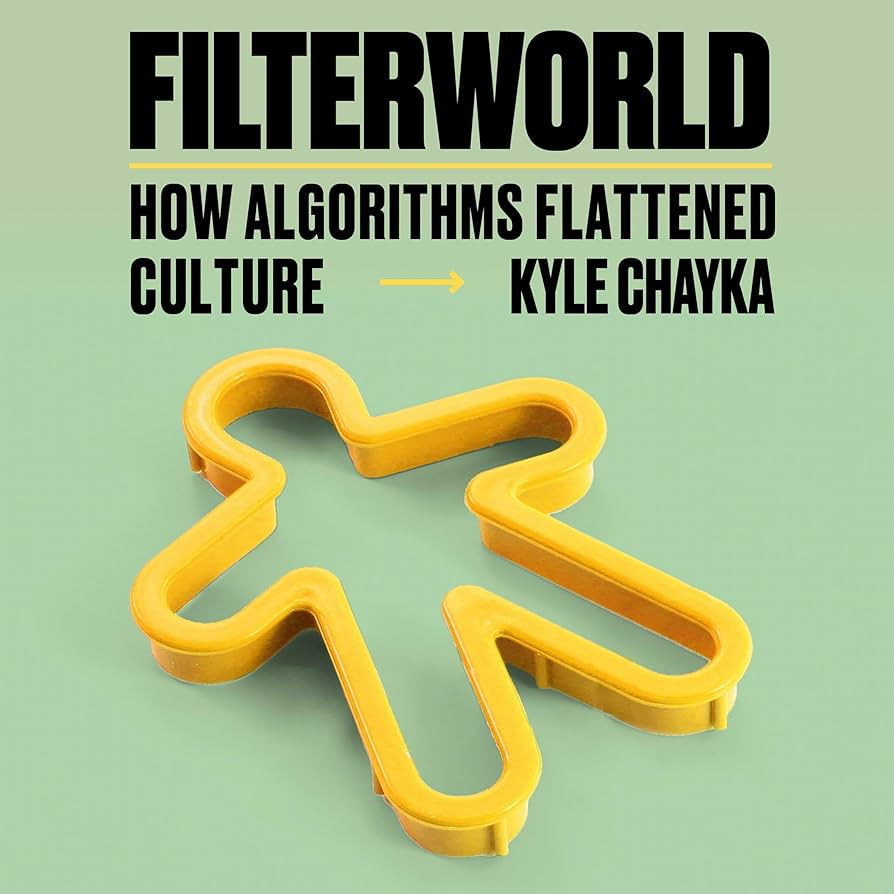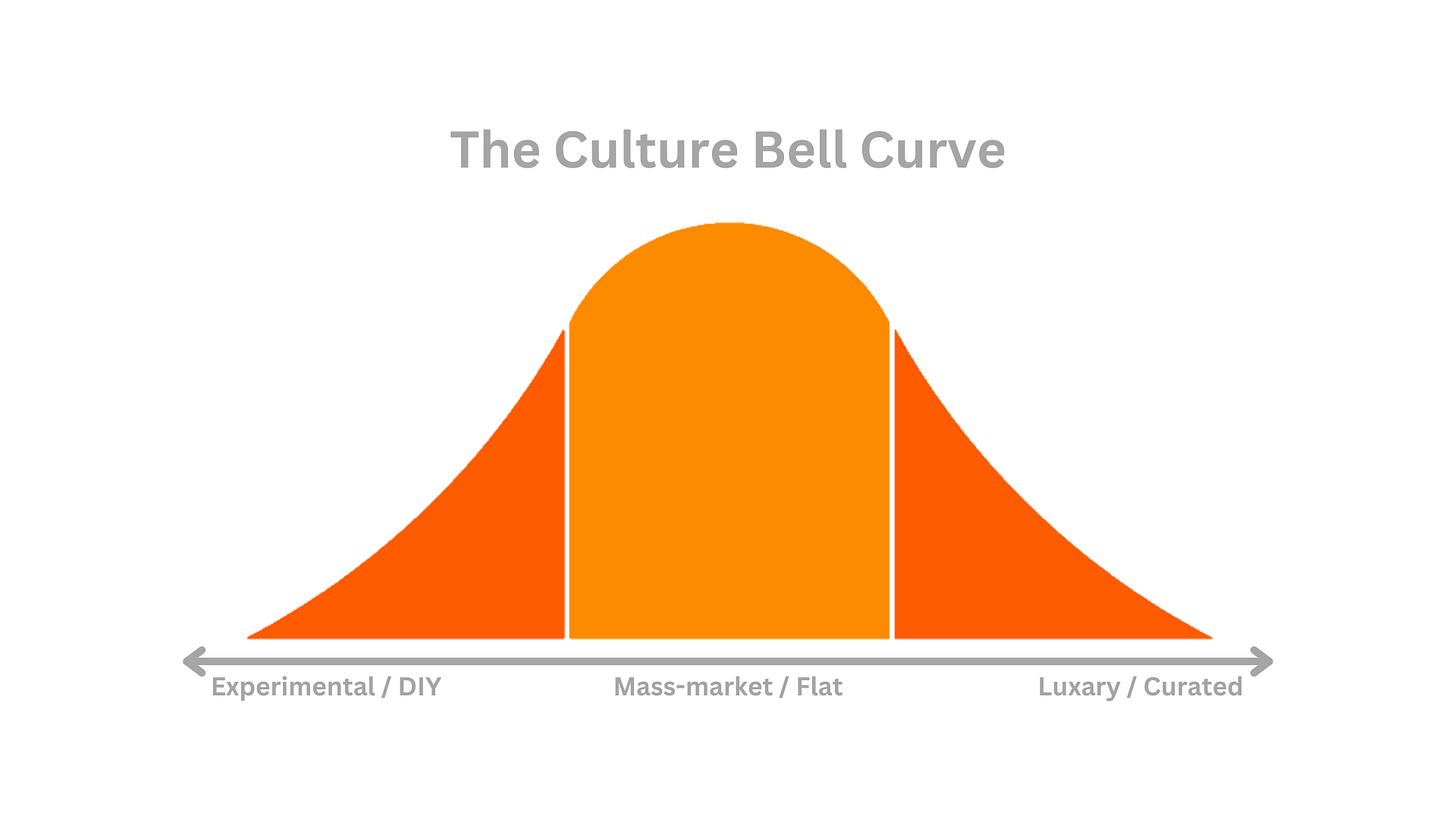EFFIGIES — Bringing nerds together to reveal the hidden wisdom of comics for fuller, more productive lives!
What’s Inside:
Algorithmic flattening.
Understanding the Culture Bell Curve.
Why I’m creating for the “edges.”
After a short break for the holidays, we’re back. I hope you had some time to unplug, recharge, and reflect as we step into a new year.
I spent some of my downtime diving into Filterworld by Kyle Chayka, and it’s had me thinking a lot about how algorithms are quietly shaping—and flattening—culture.
The more I thought about it, the more I realized how much this impacts the kind of work I want to create moving forward.
Algorithmic flattening.
Algorithms are designed to keep us engaged, but in doing so, they unintentionally flatten culture. They prioritize what's popular and safe over what's bold and original, steering creators and audiences toward the middle of the road.
Platforms reward safe bets. Content that already performs well gets pushed to more people, encouraging creators to stick with trends rather than take creative risks. This is why we see endless sequels, reboots, and rehashed ideas—they’re algorithm-friendly and guaranteed to draw attention.
At the same time, risk-taking gets punished. Studios, publishers, and independent creators avoid investing in anything too different because algorithms tend to bury content that doesn’t immediately click. Innovative work struggles to gain visibility, making it harder for fresh ideas to find an audience.
Algorithms also create feedback loops that narrow our tastes. When you engage with a certain type of content, the system feeds you more of the same. Over time, this limits exposure to new perspectives and ideas, boxing us into familiar territory.
The end result? Everything starts to look and feel the same. Movies, music, comics—they all blur together into safe, predictable content designed to appeal to the widest possible audience.
Culture becomes safer, duller, and less challenging.
Culture Bell Curve.
To better understand how culture is being flattened, imagine it as a bell curve.
On the left, you have bold, experimental, and DIY creators—artists who take risks and challenge norms.
In the middle, you have mass-market, algorithm-friendly content designed to appeal to the broadest possible audience.
On the right, you have carefully curated, deeply intentional works crafted with precision and vision.
Here’s how this looks in practice across movies and comics:
Movies
Experimental/DIY (Left Edge): David Lynch’s films (Eraserhead, Mulholland Drive) are unpredictable, unsettling, and unapologetically strange. Lynch creates for expression, not mass appeal, challenging audiences to engage deeply.
Mass-Market (Middle): The Marvel Cinematic Universe (MCU) sits squarely in the middle—designed to be broadly accessible and entertaining. The MCU aims to deliver consistent, crowd-pleasing stories that dominate box offices but rarely take creative risks.
Luxury/Curated (Right Edge): Christopher Nolan (Inception, Interstellar) crafts complex, cerebral films that balance broad appeal with meticulous storytelling. His work is challenging but still accessible, rewarding viewers willing to engage with deeper themes.
Comic Books
Experimental/DIY (Left Edge): The Crow by James O’Barr is a raw, emotionally charged, self-published comic born from personal tragedy. Its gritty, hand-drawn style and brutal honesty made it a cult classic without any need for mainstream polish.
Mass-Market (Middle): The Amazing Spider-Man is a cornerstone of mainstream comics. It’s consistent, mostly family-friendly, and designed to appeal to as many readers as possible. It’s reliable but rarely groundbreaking.
Luxury/Curated (Right Edge): Watchmen by Alan Moore and Dave Gibbons is a meticulously crafted, layered narrative that deconstructs superhero mythology. It’s intentional, complex, and has influenced the comic medium in lasting ways.
The middle is safe. It’s predictable. And it’s where algorithms naturally guide us. But the work that truly changes culture—the kind that sticks with us—lives at the edges.
Creating for the edges.
As I think about the stories I want to tell in comics and beyond, and as I reflect on the work I’ve already done, I’m realizing that I want to create stories for the edges.
All of my creator-owned work—GRIEF, Dead End Kids, No Heroine, and Unborn—exists in a liminal space between the two edges. Content-wise, they attempt to play with conventions (coming-of-age stories in DEK) and forms (short stories in GRIEF) while keeping the stories fairly grounded in character and raw emotion (No Heroine and Unborn). This is the DIY end of the curve.
Each of these series also touches the curated edge of the curve because of the packaging and design elements that are incorporated in and across them. From the chapter pages in GRIEF that tell their own story to the eye-catching trade dress of Dead End Kids, there is an intentionality to the works and the body of work.
Even Power Rangers: Edge of Darkness, easily my most mainstream piece of comics work, I think, stands a bit to the side of other Power Rangers stories because of the emotional depth I was shooting for that comes wrapped in BOOM! Studios’ consistently stunning graphic design.
On one side, I’m drawn to the DIY, punk rock mentality—the scrappy, self-made, “let’s figure it out and make it happen” approach. It’s raw, it’s real, and it’s where some of the most honest storytelling lives.
On the other side, I admire the curated, deliberate creators who obsess over every detail, who make work that’s uncompromising in its vision. That kind of work demands attention and rewards patience.
The middle? That’s not where I want to be as a creator.
Culture diet.
The middle of the cultural bell curve is flat—and that’s by design. It’s built to be broadly appealing, easy to consume, and inoffensive. As a creator, though, that middle ground doesn’t excite me. It doesn’t challenge or inspire me, and it’s not the space where I want to create.
As a consumer, I don’t mind it in small doses. Just like grabbing a handful of potato chips, sometimes I want something light, easy, and familiar. But if chips made up my entire diet, I’d feel sluggish and unfulfilled. The same goes for culture. If I only consumed mass-market, algorithm-approved content, I’d be missing out on the stories and ideas that push boundaries and make me think.
I want the bulk of my cultural diet to come from work that challenges me, inspires me, or leaves me in awe. That means seeking out bold, independent creators who take risks or diving into thoughtfully crafted stories that don’t cater to the broadest audience. This is the kind of work that sticks with you long after you’ve finished it—the kind that makes you reflect, feel something deeply or see the world differently.
That’s also where I want to operate as a creator. I’m not interested in making something that just checks a box and blends into the noise. I want to make comics that connect with people on a deeper level, even if that means speaking to a smaller, more dedicated audience.
The middle can stay where it is—but I’ll be over at the edges.
—Frank
I’m Frank Gogol, writer of comics such as Dead End Kids, No Heroine, Unborn, Power Rangers, and more. If this newsletter was interesting / helpful / entertaining…
After credits scene.
With all of the above in mind, what are your suggestions for media that’s being created at the edges? I read a lot, but also enjoy TV, movies, and video games. So if there’s anything I should be checking out (even in a medium other than those I mentioned), I want to know. Drop your recs on the comments.





